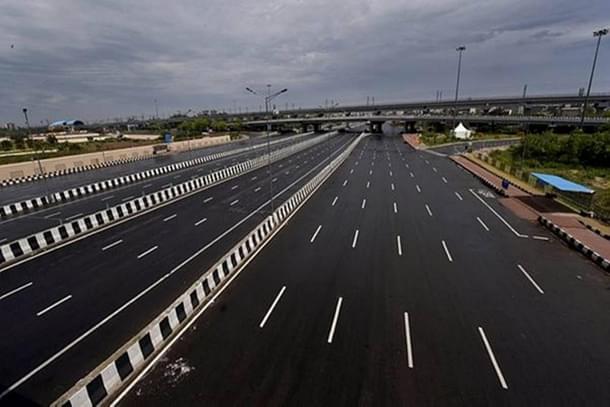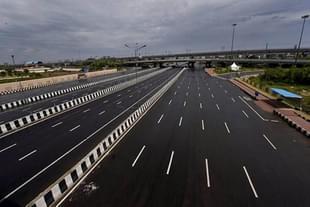Infrastructure
Despite Speed Bumps India's National Highways Project Racing Ahead
Amit Mishra
Apr 07, 2022, 06:31 PM | Updated 06:29 PM IST
Save & read from anywhere!
Bookmark stories for easy access on any device or the Swarajya app.


Union Minister for Road Transport and Highways Nitin Gadkari inaugurated and laid foundation stone for National Highway (NH) projects worth Rs 4,135.91 crore at a function held at Panvel, Mumbai on Sunday (3 April 2022). The development work comprises dedication of Rs 3,500 crore JNPT Port Road Connectivity Project to the nation and ground-breaking ceremony for work on National Highway No 48, Mumbai-Pune Expressway, and the eastern entrance of proposed Navi Mumbai International Airport
NH Network In The Country
An intricate, robust and well-maintained road network spanning the length and breadth of a country, acts as a fundamental enabler for its overall economic and social development by permitting efficacious movement of freight as well as passengers. Road transport handles bulk of countrywide passenger and freight traffic in India, while also complementing other modes of transport by providing and ensuring last-mile connectivity.
India has the second largest road network in the world of about 63.72 lakh kilometres, consisting of NHs, expressways, state highways (SHs), major district roads, other district roads and village roads.
National Highways are the arterial roads of the country for inter-state movements of goods and passengers. They traverse the length and breadth of the country connecting the national and state capitals, major ports and rail junctions and link up with border roads and foreign highways.
There are 658 NHs in the country having total length of 141,190 km as on 31 January 2022. Though it comprises only 2.3 per cent of total road network, yet it carries about 40 per cent of the road traffic.
The total length of NHs in the country has increased from about 91,287 km in April 2014 to 141,190 km as on 31 January 2022, registering a splendid 50 per cent growth in eight years. Note that since 2014-15, about 49,339 km of state roads have been notified as national highways.
The government of India had launched major initiatives to upgrade and strengthen NHs through various phases of the National Highways Development Project (NHDP) and is taking the initiative forward through the umbrella programme of Bharatmala Pariyojana (Phase-I), development of road in left wing extremism affected areas, Special Accelerated Road Development Programme for North-East (SARDP-NE), etc, taking into account their impact on tourism potential, trade potential areas, strategic, tribal, remote and border areas.
Legal Framework
The Ministry of Road Transport and Highways has been entrusted with the responsibility of development of road transport and highways in general and construction and maintenance of NHs in particular. The National Highways Authority Act, 1988 led to the creation of National Highways Authority of India (NHAI) to look after these highways.
Section 2 of the National Highways Act, 1956, gives the central government the exclusive right to notify any road in the country as a national highway and add it to the list of national highways annexed to the act.
The act also gives the central government the right to announce through the national gazette the removal of any national highway from the list.
The Union Ministry of Road Transport and Highways, in consultation with the erstwhile Planning Commission, had come up with 11-point criteria for declaration which, if met, could put a road up for consideration to become a national highway.
The criteria include roads running through length/breadth of the country; road connecting adjacent countries, national capital with state capitals/mutually the state capitals, major ports, non-major ports, large industrial centres or tourist centres; roads having important strategic requirement in hilly and isolated area; arterial roads which enable sizeable reduction in travel distance and achieve substantial economic growth; roads which help in opening up large tracts of backward area and hilly region and roads contributing towards achievement of national highways grid of 100 km.
Role Of States
State governments can send proposals to the central government to upgrade state roads/highways to national highways. State roads including state highways are declared as new NHs from time to time on the basis of well established criteria.
Keeping in view numerous proposals received from time to time from various state governments, peoples’ representatives, various ministries, etc, the ministry has taken a view to consider approving state roads ‘in principle’ as new NHs subject to outcome of their detailed project reports (DPRs). Accordingly, agencies such as state PWDs, NHAI, NHIDCL, are requested to take up preparation of DPRs for such state roads; further decisions regarding notifying such roads as new NHs are taken up depending upon outcome of their DPRs
Every time the Union cabinet approves an upgradation, it has to be notified through the national gazette, and the list of NH in the National Highways Act, 1956, has to be amended.
About 49,339 km length of state roads, including state highways, has been declared as new NHs since 1 April, 2014 till date. This includes 6,174 km in 2018-19, 495 km in 2019-20, 5,381 km in 2020-21 and 2,813 km in 2021-22 (upto 17 March 2022).
Development Of NHs
Development and maintenance of NHs is a continuous process. The works on NHs are accordingly taken up depending upon requirement of connectivity, inter-se priority, traffic density and fund availability. The ministry takes up new NH projects through its implementing agencies like NHAI, NHIDCL, state PWDs, BRO, etc.
Targets for the construction of NHs are finalised on year to year basis. In order to provide a boost to infrastructure development and enable it to overcome the impact of Covid-19 pandemic, the ministry has set the highest ever target of 12,000 kms for construction for the year 2021-22, against which about 6,684 km length has been constructed upto month ending January, 2022.
The ministry, during its presentation in the meeting of the Committee on the Demands for Grants (2022-23) of the ministry, held on 16 February, 2022 informed the committee that for FY21-22, about 56 per cent of annual target of construction has been achieved till January, 2022 and is expected to reach its target of about 12,000 km by March, 2022.

Finance Minister Nirmala Sitharaman, in her budget speech for 2022- 23 announced that the country’s national highways will be expanded by 25,000km in 2022-23. An allocation of Rs 20,000 crore has been proposed for the project.
Pace Of Construction
The pace of NH construction in the country increased from 12 km per day in 2014-15 to a record high of around 37 km per day in 2020-21 (by more than 3 times).
Despite the pandemic and the lockdown in 2020, the ministry ended the financial year ending March 2021 on a high, having constructed 13,327 km of highways, or 36.5 kms per day — a record. According to the Economic Survey 2021-22, the extent of road construction per day in 2020-21 rose substantially by 30.4 per cent from 28 kms per day achieved in 2019-20.
The significant upturn in road construction in 2020-21 was due to the increase in public expenditure by 29.5 per cent as compared to the previous year — a reflection of the impetus given by the central government to a critical sector that generates employment and supports infrastructure during a pandemic year, noted the survey.
In 2019-20, India’s highways construction had missed its previous year’s figures by a whisker. That year, the construction figure stood at 10,237, which was just about 500 km less than the previous year’s 10,855 km.
The Ministry of Road Transport had initially set an ambitious target to build 14,600km of highways in 2021-22, requiring building 40 km of roadway daily. However, midway into the year, with the pace not picking, the target was downsized to a realistic 12,000 km, or about 32 km per day.
Current estimates are that FY 2021-22 is likely to end with around 10,500 km of highways, translating to around 28 km per day. This would take the highway construction progress to the levels of 2018-19, when India constructed 10,855 km of highways, or about 29.7 km a day. The highway construction has hit a speed bump on account of initial set back due to effects of Covid-19 outbreak, prolonged monsoon in many parts of the country, etc.
The government is targeting a pace of 50 km per day for national highways' construction in the country. "Now, we want to go up to (construct) 50 km per day (highway)," said Union Minister for Road Transport, Nitin Gadkari, while addressing ET Global Business Summit' virtually in March 2022.
Mode Of Implementation
The NHs in the country are constructed both under public funded mode and public private partnership (PPP) mode.
In public funded model, 100 per cent funding is provided by government. It can be categorised into item rate and engineering, procurement and construction (EPC) mode.
In EPC projects, responsibility for design and development of the project is vested with the contractors for the projects. The contracts specify broad project scopes and requirements and does not provide for individual item-wise quantities/rates. Payments are linked to specified stages of construction. The contract price is subject to adjustment on account of variation in the cost and change in scope ordered by employer. Scope for adopting best practices and innovation to optimise the efficiency and economy is available in such types of model.
The contractor is responsible for maintenance and rectification of defects arising in the project section during the concurrent maintenance-cum-defects liability period, which is four years as per extant policies. There is separate provision for payments for maintenance of the project section to the contractors.
There are three variants of PPP projects, namely, BOT (toll), BOT (annuity) and hybrid annuity employed for highway development in the country.
In BOT (toll) projects, responsibility for design and development of the project is vested with the concessionaire for the project. The concessionaire is also responsible for operation and maintenance (O&M) of the project for the entire concession period after it is developed and put to commercial operation. The concessionaire has tolling rights during concession period after declaration of commercial operation of the developed section. The tolls are prescribed by the authority on per vehicle per km basis for different types of vehicles.
As in case of BOT (toll) projects, responsibility for design, development and O&M of the project section for the entire concession period is vested with the concessionaire for the project under BOT (annuity) model. Concessionaire is given annuity payments during the O&M period as per provisions of the concession Agreement. Tolling rights during O&M period vest with the employer after declaration of commercial operation of the developed section.
Under the newly introduced hybrid annuity model (HAM), 40 per cent of the project cost is paid by the government/executing agency as construction support/grant to the private developer and the balance 60 per cent is to be arranged by the successful bidder through a mix of equity and grant during the construction period. The concessionaire is paid back the amount of 60 per cent along with interest, O&M payment in the form of annuities during operation period. While the concessionaire is responsible for the O&M during the concession period, the traffic risk is taken by the project executing agency/employer. Tolling rights during the O&M period are vested with the employer after declaration of commercial operation of the developed section.
According to a report by Credit rating agency Crisil, more than half of the road projects awarded by NHAI are under the HAM mode. Another 40-45 per cent is under the EPC mode and less 5 per cent under the BOT (toll) mode, the report noted.
Amit Mishra is Staff Writer at Swarajya.





